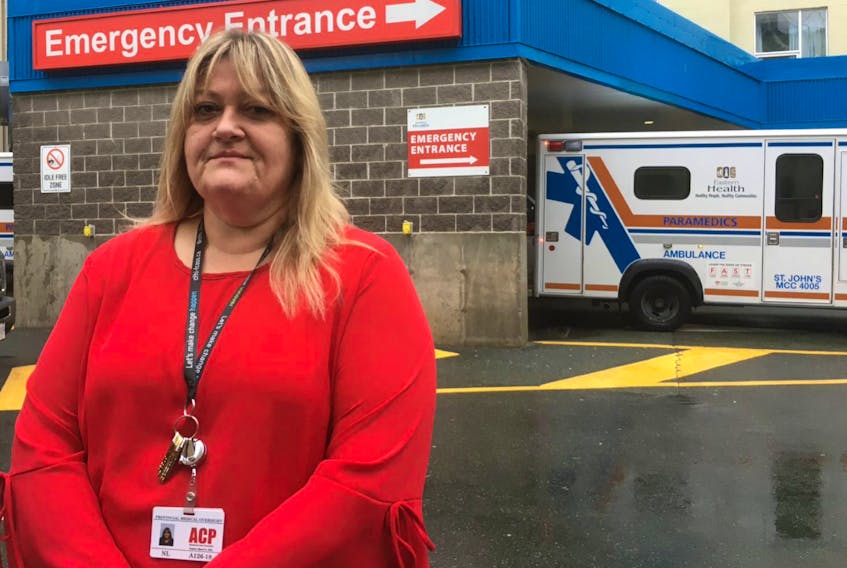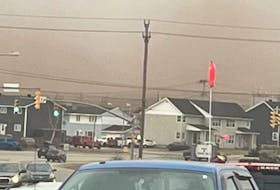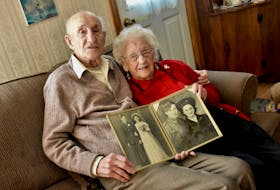ST. JOHN'S, N.L. — Eastern Health has done away with the term “red alert” to warn of strained ambulance resources in the St. John's metropolitan area.
The optics of “red alert, red alert” called out by ambulance dispatch — which could be heard over scanners if used in radio transmissions — was a public relations disaster for the health care authority, as the frequency of the alerts resulted in media coverage, union criticism and poor public perception.
“I agree with you (red alert, red alert) is frightening and unless we are going to come right behind and say, ‘Oh disregard, we’re good,’ that just leaves the message we never go back and sort it out,” Michelle Breen, Eastern Health's regional director of paramedicine and medical transport, told The Telegram in an interview on paramedics’ concerns.
This fall, a memo was sent to Eastern Health paramedics in the wide metro coverage area served by St. Clare’s Hospital and the Health Sciences Centre notifying them of the procedural change banning the term “red alert” from the medical communications centre due to the erosion of public confidence.
Breen, who took her job 2 1/2 years ago, said the term wasn’t familiar to her in other paramedicine jurisdictions — she previously worked in New Brunswick — and was concerned the public rarely heard that the red alerts were resolved, often within minutes.

“It wasn’t a coverup or anything,” Breen said of the decision to stop saying “red alert.”
The memo was one of a number of issues raised in a letter to The Telegram sent anonymously, because the paramedics fear reprisals due to confidentiality rules. Most of the issues, however, have been verified as concerns raised to both the union and the employer.
Many of them, including concerns about the number of red alerts, have been around for years, even decades, but seem to be boiling over.
“Paramedics feel that they are at a breaking point and are begging for change,” said the letter.
“Paramedics feel they are being constantly pressured and silently warned to live up to the public perception and not ruin it. This is very difficult due to lack of resources. The information out there is misleading to the public, the people they care so much about. The mental health and emotional well-being of the medics are at an extremely high risk and these are the people you call when in a crisis.”
It wasn’t just the employer faulted for what they see as a lack of movement on issues, but also the Newfoundland and Labrador Union of Public and Private Employees (NAPE).
“Most medics feel their union is powerless and wishes they had a union that would fully support them and make things happen,” the letter stated.
This story and coverage coming Nov. 21 from the Telegram will tackle the paramedics’ list of frustrations and what the union and Eastern Health have to say about them.
The red alert warning was set up to notify crews that the last ambulance was just sent out and there may or may not be a call waiting.
“And if there is a call waiting, it doesn’t necessarily mean it’s a critical call. It’s not always life or death,” Breen said.
“What we were seeing in social media was it wasn’t a true reflection of Eastern Health or metro paramedics' ability to respond. The fear was there was an erosion in public confidence and we were seeing that with social media posts and Twitter where the public said they heard the red alert and so they were hesitant to call because the system was overburdened and there was no truck available, so they wouldn’t call. That is not necessarily always the case,” Breen said.
“I thought wow, you know, to just put that over the radio, put it out there in the public where the scanners are there so from their perception, there’s no truck. ‘Oh my goodness, we don’t have an ambulance.’”
But what’s not heard by the public is the conversation on the cellphone system crews now use because of limited radio bandwidth or transmission issues inside buildings, Breen said.
"What we were seeing in social media was it wasn’t a true reflection of Eastern Health or metro paramedics' ability to respond." — Michelle Breen, regional director of paramedicine and medical transport with Eastern Health
And going on in that background is that a crew may be responding they are almost ready to go after finishing another call, she said.
As well, using the computer system implemented in the spring, dispatchers can track which ambulances are close, which ones can stand down from a nursing home transfer or other less urgent calls.
“But the public is not hearing that on the radio, so we throw it out there, no trucks available, but we never retract it,” she said.
Instead of red alerts, the terminology used over the radio now more reflects that of a taxi dispatch system, in which ambulance teams are asked who’s available and who’s nearby.
“Now we’re not hiding anything. When we deploy our last unit, our last ambulance, when that happens there are times when there is no feedback, when everyone is tied up when they’re all on calls, so then we turn to mutual aid,” Breen said.
“And that’s no different than anyone across the country, really. You can’t predict the peaks and valleys sometimes. It takes one car accident and a multiple collision with four patients and in a microsecond you are depleted.”
In previous years, Breen said, the red alerts were hand logged on paper and resolutions may not have been recorded along with them.
The new computer-aided dispatch system offers data that is more accurate in terms of the effect on resources, as all that information for each ambulance is automatically time stamped — there hasn’t been enough of a timeframe for a comprehensive analysis, but that’s coming soon, Breen said.
Risky delays
NAPE president Jerry Earle said issues like the red alerts can’t be put on the back burner any longer.

“Softening the terminology does not fix the problem,” he said of the memo.
He said even a short delay puts the public at risk of an ambulance not being available at a crucial time.
“I was always taught that minutes matter. Every minute matters,” Earle said.
To ban the terminology, he said, is to be dismissive of the problem.
In June, NAPE revealed an access to information response that indicated there were 957 instances in the previous 28 months when an ambulance was not immediately available to respond to a call.
To that date, there were 156 red alerts accounting for 3,283 minutes.
Tuesday, Earle said those statistics speak for themselves.
As for lashing out at the union, Earle said as a former paramedic and union rep who once occupied a CEO’s office demanding change, he understands that.
“I understand people getting frustrated. I’ve got no bone to pick. I’ve been there myself,” Earle said.
The anonymous letter said paramedics reacted to the memo by calling it smoke and mirrors.
Twitter: @BarbSweetTweets
READ PART 2
RELATED









